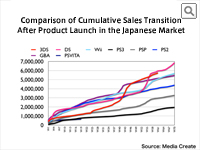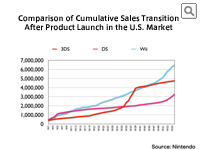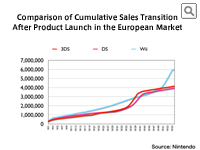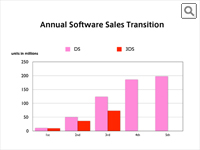| |
Allow me to first say that I think President Iwata is now being exposed to a bashing from the mass media and I would like him to hold on and go undefeated by them. And, my question is, in my opinion, the factor which has the biggest impact on hardware sales expansion is the existence of killer titles, such as “SUPER MARIO 3D LAND,” “Mario Kart 7” and “Monster Hunter 3 (Tri) G,” rather than a hardware system’s 3D viewing capabilities or tablet-like controller. Are you intending to launch the Wii U hardware together with some killer titles from day one in order to drive the hardware sales? How have you allocated your managerial resources in order to successfully launch the Wii U? On another topic of so-called social games, they include the business model which is close to that of Pachinko (a Japanese type of slot machine business). They are making money so easily today that I have to wonder if the third-party publishers may be losing interest in investing billions of yen to develop a title for home console video game systems like the Wii U. How has Nintendo been trying to motivate the third parties to work on your hardware system? |
|---|---|
| |
Iwata: First of all, thank you for your encouragement. However, with the financial results that we have announced, it is natural that I am being criticized. I do not feel that I have been experiencing something unreasonable. I am making efforts so that the situation can change as soon as possible. I would like to share with you our philosophy in the game business. This is one of the remarks made by our former president, Hiroshi Yamauchi, and is widely known in the video game industry: “Our consumers do not want to purchase the game systems themselves but want to play with the game software.” To take this idea to the extreme, consumers reluctantly purchase a hardware system simply to play with the game software. Of course, the video game hardware systems of today embody a variety of functionalities within them and offer a lot of experiences to the consumers. As the company has already included a variety of built-in software that our consumers can enjoy as soon as they purchase the hardware even before purchasing any software, the environment is a bit different from when Mr. Yamauchi made such a remark. Having said that, however, even today, I do not think the consumers are purchasing our hardware just in order to enjoy the built-in applications. The actual situation is that our consumers happen to find out how fun the built-in applications are as a result of purchasing the game hardware system. So, the primary purpose of consumers purchasing our hardware is to play with the very well-made purchased game software that they really want to play with for themselves. As we look back, when we launched the Nintendo 3DS, we failed to prepare a software lineup which could satisfy our consumers in addition to other factors, and the Nintendo 3DS could not initially increase the sales as we had originally expected. This is why the company needed to carry out such a drastic markdown measure by sacrificing the profitability. As a result, and supported by a strong software lineup, the Nintendo 3DS was able to regain momentum during the year-end sales season of 2011. We laid out such a drastic measure by understanding that regaining the momentum which had been once lost, is much harder than trying to create momentum from scratch. Without it, the Nintendo 3DS could not have realized positive results at the end of last year or the current sales pace in Japan. It did hurt our financial results, but it was a necessary measure. So, how will we be able to use this lesson for the Wii U? There is always a limit to our internal resources. The company now has to develop software for the Nintendo 3DS, has to prepare for the Wii U launch and has to finalize the hardware functionalities. With these circumstances in mind, if I said that an overwhelmingly rich software lineup would be prepared from day one, it would be too much of a promise to make. On the other hand, we are making efforts so that we will be able to make several proposals even from the launch period that can eventually become evergreen titles for the Wii U. We have learned the lesson that we have to make that kind of preparation for the Wii U, or the Wii U will not gain enough momentum to expand its sales. We would like to share additional information at the E3 show in June this year. As for your opinion that the software publishers are devoting comparatively less software development resources to the so-called consumer games than before, I share that idea with you. Because Nintendo has been devoting all of its resources to the software creations of the so-called consumer game systems, and as we have even expanded the software development efforts in that arena more than before, our ability has increased in comparison to that of five years ago. When we take into consideration these changes, it may be true that software publishers are devoting relatively fewer internal resources to the development of consumer games than before. Having said that, however, as a matter of course, not all the internal developers (of the publishers) have lost their passion to create consumer game software. It is imperative for Nintendo that our new hardware offers new proposals and potentially new play experiences so that developers will be interested in this hardware and be motivated to make attractive software. At the E3 show this June, you will be able to experience not only Nintendo’s Wii U software but also the titles being prepared by the third-party publishers. As a result, I think you will be able to notice that a number of developers are creating software (for the Wii U) even today. As for the Nintendo 3DS, there may appear to be fewer commitments from the U.S. and the European software publishers than those of their Japanese counterparts. This is due to the different timing (between Japan and overseas) when they noticed that the Nintendo 3DS would surely expand widely into their markets and, thus, the different timing when they started the actual development of the Nintendo 3DS software. You will also notice a change in this situation when a richer Nintendo 3DS software lineup in the overseas markets is announced around the time of the E3 show. In Japan, we have this solid feeling that the Japanese publishers will continuously support the Nintendo 3DS. Accordingly, I have no pessimistic view on the Nintendo 3DS software lineup. |
| |
I would like to ask about the Nintendo 3DS software, and specifically about the direction to which the software technologies are supposed to evolve from now, the room for improvement in software-related technologies and your policy on sharing with your third-party publishers the technologies and know-how you have acquired. For example, when you developed “Mario Kart 7” and “SUPER MARIO 3D LAND,” I heard that significant evolutions were made in terms of where to set the 3D image base level and how to present a 3D gaming world to consumers, which have allegedly contributed to major improvements in creating this kind of software. Would you elaborate on these factors? Which areas in your development activities do you think still have room for improvement? Are you willing to share the related techniques with your third-party publishers, or is it your stance that they should look at what you have done and follow your ways? |
|---|---|
| |
Iwata: Let me first explain about the principle of 3D viewing. The developers create different images for the viewer’s left eye and right eye, with which the viewer can feel the combined image as stereoscopic. There is a point where the images for the left eye and the right eye are identical, and we technically call it the “base level.” In other words, 3D tuning in game development means deciding on where the base level should be located in the depth of the 3D gaming world, the location of the images which should appear to pop up and come closest to the player’s eyes, and the location of the images which should be placed at the deepest point of the 3D gaming world to represent the depth. If I can explain a little more about what our developers actually did during development, they started to discuss how “Mario Kart 7,” then in development, was able to create the circumstance where the test players felt that the 3D images were very natural, they could play with the prototype software more easily and it was more comfortable for the eyes than for “SUPER MARIO 3D LAND.” They discussed the differences “Mario Kart 7” developers had implemented and eventually decided to make “SUPER MARIO 3D LAND” so that the players could switch between two modes of 3D viewing. We included the two modes because, when we changed the relevant program after learning from the “Mario Kart 7” programing, approximately 20% of Nintendo employees who tested both versions preferred the pre-change mode. We have learned that different preferences exist when it comes to 3D viewing. This sort of learning can be made only after playable prototypes of software with much depth can be prepared and test players can try to understand if they are able to play the prototype in a way that the 3D feels very natural. For the first time, “SUPER MARIO 3D LAND” (thanks to the 3D viewing capability of the Nintendo 3DS) rather naturally represents for the players where in the 3D gaming world each character and object exists in terms of the depth and the height of the world, which was not possible with any other existing gaming hardware system. For example, those who have played “SUPER MARIO 3D LAND” must have had the experience of feeling the sensation of falling from a very high place. The game must have provided players with such simulated experiences as in real life because the company has received such feedback from the players as “I felt weak at the knees!” or “I got chills!” The company has gradually been able to learn and acquire the development know-how and programing techniques relating to 3D viewing by continually developing and playing with the applicable software. Ideally, we should have understood all of these points and launched the Nintendo 3DS with all of these proposals. However, as the history of video game hardware systems has shown, it is not feasible for any video game system to be accompanied by the software that takes advantage of 100% of the hardware system’s potential from its launch period. The actual and full hardware potential can be gradually leveraged just as the hardware expands its installed base in the marketplace. History has shown that what used to be impossible in the first generation of the software lineup for a hardware system only becomes possible in its second or third generation. From that perspective, what our developers have discovered in the process of developing “SUPER MARIO 3D LAND” and “Mario Kart 7” are the first phase of fine-tuning techniques for 3D viewing, which can result in a natural game play experience for the player, I believe. As to your question on how Nintendo is willing to disclose such know-how, as long as software publishers of the Nintendo 3DS make the relevant inquiries to us, we are willing to disclose what we have done, and we are actually sharing the information with them. Rather than keeping this sort of know-how confidential and trying to leverage upon it to give our software a competitive edge, we believe that it is more beneficial for the company if all players will comment, “All the Nintendo 3DS software looks natural to our eyes and very attractive as we feel that the images are really 3D.” So, when we are asked, we are eager to support our third-party publishers. |
| |
In terms of financial performance, the president commented in the last Corporate Management Policy Briefing that the company was aiming to get back to the level of the profitability that can be called “Nintendo-like” profits. We were exchanging assumptions among ourselves that it could be 100 billion yen or 50 billion yen. I would like to know how you assess the operating profit for the fiscal year ending March 31, 2013 that the company just forecasted, which is 35 billion yen. The operating profits of 35 billion yen may disappear if the actual software unit sales end up being 20% lower than those in the forecast. Is it your policy that in terms of business performance, you first put several strategies in place to drive the business and come up with the financial performance as a result, rather than set a numerical goal first and then aim to achieve it? If not, do you have a specific target of when the company will be able to achieve “Nintendo-like” profits? |
|---|---|
| |
Iwata: When I was asked at the press conference for earnings releases held in Kitahama, Osaka yesterday if the forecasted operating income the company announced should be considered “Nintendo-like” profits, I replied that 35 billion yen of operating income was not what we consider “Nintendo-like” profits. I don’t think I should simply put a specific numerical figure on what we do consider “Nintendo-like” profits and let that number spread as if it has taken on a life of its own, but I can say that 35 billion yen is not good enough for us. The company set a minimum level of dividend per share for this fiscal year, but doing so to alleviate our shareholders’ and investors’ concerns, or causing you to share your concern on the possibility of the 35 billion yen operating income disappearing if the actual software sales end up being 20% lower than the forecast are both undesirable situations for Nintendo in the first place. On the other hand, setting a financial goal without having any concrete grounds is not an appropriate way to establish financial forecasts. We consider them by closely looking at the current and future conditions. This slide shows an update of the chart, which we showed at the Corporate Management Policy Briefing this January, that represents unit sales trends of each hardware system. The sales in the second year of the Nintendo DS grew drastically thanks to the sales of the combination of both “Brain Age” and “Brain Age 2.” And, “Animal Crossing: Wild World” and “Mario Kart DS” contributed to the growth as well. The sales trend of the Nintendo 3DS after the turn of the year clearly surpassed those of the past hardware systems that sold very well although they were slightly lower than the level of the Nintendo DS, which grew explosively. The sales trend of the Nintendo 3DS in the Japanese market has been within my expectation, but, the U.S. and European sales trends have not. The start of the year-end sales season was slower than the last few years although the sales did pick up at the year-end, and the sales after the turn of the year did not meet my expectations. This is the comparison data in the U.S. market. The sales of the Nintendo 3DS have been much better than those of the Nintendo DS, which were boosted very slowly, but I am not satisfied with the actual sales of the Nintendo 3DS because the trend since the start of this calendar year has not been good enough. In the Japanese market, the weekly sales of the Nintendo 3DS continue to be more than 60 thousand units recently and, in some weeks, they have recorded 80 thousand or 100 thousand units. Since the U.S. market is two or three times bigger than that of Japan, I am not satisfied with the current level of the Nintendo 3DS sales in the U.S. market. I don’t think the current sales momentum in the U.S. is very strong. In the European market, the sales of the Nintendo 3DS have been better than those of the Nintendo DS in its early stages, which were better than those in the U.S. However, I am not satisfied with the European sales either. Considering these circumstances, I don’t think we can make an aggressive sales forecast for the Nintendo 3DS software. This slide shows how the software sales of the Nintendo DS and the Nintendo 3DS have changed year on year. A big leap in sales usually occurs in the third year after the hardware launch, and the third or fourth year becomes a harvest season to sell a lot of software. However, (when we consider the situation in the overseas markets,) we can’t help making the forecast not so aggressive in comparison to the corresponding years for the Nintendo DS. Of course, we are aiming to create good momentum in the (overseas) market after summer and make an explosive increase in sales during the year-end sales season, but since we couldn’t make aggressive forecasts of the sales early in this fiscal year, the software sales forecast for the full year became a little bit modest compared to how the software sales are generally expected to increase in the hardware’s third year on the market. When we can make the improvements in the software sales, they will further gain momentum and contribute to the business performance during the full year, the next fiscal year and beyond. In addition, the Wii U in the second year of its launch will contribute to the business performance over the full fiscal year (ending March 31, 2014). Considering these situations, the overall profitability of the software business will gradually improve and, in that sense, we expect people will say, “You have ‘Nintendo-like’ profits again,” and we would like to realize this situation as soon as possible. |



